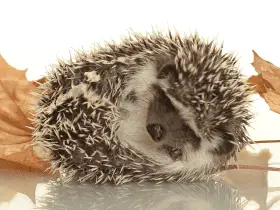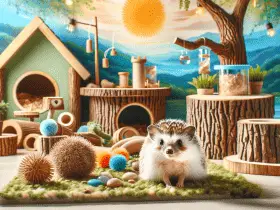Are you ready to uncover the truth about hedgehogs? Join us as we dive into the world of these spiky creatures and separate fact from fiction.
In this article, we will debunk 10 popular hedgehog myths that have been circulating for far too long. From their suitability as pets to their hibernation habits, we will set the record straight on all things hedgehog-related.
So grab a cup of tea, sit back, and let’s embark on this myth-busting journey together.
Key Takeaways
- Hedgehogs are social animals and enjoy human interaction.
- Balanced diet is crucial, including high-quality cat food, insects, fruits, and vegetables.
- Hedgehogs enter a state called torpor during hibernation.
- Quills serve as a defense mechanism, not a weapon.
Hedgehogs as Pets: Separating Fact From Fiction
Hedgehogs can make great pets if you have the right knowledge and resources. However, there are some important factors to consider before bringing a hedgehog into your home.
First, it is crucial to understand the legalities surrounding hedgehog ownership in your area. While hedgehogs are legal pets in many places, there are still some locations where they are prohibited. Make sure to check with local authorities or animal control to ensure that you can legally keep a hedgehog as a pet.
Secondly, hedgehogs require proper socialization to thrive in a domestic setting. Contrary to popular belief, these adorable creatures are not solitary animals. In fact, they enjoy human interaction and can form strong bonds with their owners. It is essential to spend time with your hedgehog every day and provide them with mental and physical stimulation through play and exercise.
To ensure the best care for your pet hedgehog, it is vital to educate yourself on their needs and behaviors. Joining online communities or seeking guidance from experienced owners can be beneficial for both you and your new companion.
Hedgehogs and Hibernation: Busting the Myth
During hibernation, hedgehogs actually lower their body temperature. They do not go into a deep sleep, but enter a state called torpor. Torpor slows down their metabolism and drops their body temperature significantly. This adaptation allows them to conserve energy and survive the winter months.
Here are three interesting facts about hedgehog hibernation patterns and the environmental factors that influence them.
Hedgehogs sense changes in temperature and daylight hours, triggering their hibernation process. They begin preparing for hibernation in late autumn when food becomes scarce.
The duration of hedgehog hibernation varies depending on external conditions. In milder climates, they may only hibernate for a few weeks or not at all. In colder regions with longer winters, hedgehogs can remain in torpor for several months.
Hedgehogs must find suitable hibernation sites to ensure their survival. They seek out cozy spots like piles of leaves, burrows, or man-made structures like log piles or compost heaps.
Understanding these hibernation patterns and environmental factors is essential for anyone caring for pet hedgehogs or studying these creatures. By providing suitable habitats and ensuring enough food reserves before winter, we can help support healthy hedgehog populations across different regions.
Hedgehog Diets: What They Really Need to Eat
To ensure the health and well-being of your pet hedgehog, it’s important to provide them with a balanced diet that includes a variety of insects, fruits, and vegetables. Hedgehogs have unique feeding habits and nutritional requirements that need to be met in order for them to thrive.
In the wild, hedgehogs are opportunistic eaters and will consume a wide range of food items. In captivity, it is essential to replicate their natural diet as closely as possible. Insects such as mealworms, crickets, and waxworms should make up a significant portion of their diet. These provide essential proteins that help with growth and maintaining overall health.
Fruits and vegetables should also be included in their diet to ensure they receive the necessary vitamins and minerals. Examples include apples, carrots, blueberries, and leafy greens like spinach or kale. It’s important to note that while fruits can be given daily, veggies should only be offered two or three times per week.
Additionally, providing access to fresh water at all times is crucial for proper hydration.
Hedgehog Quills: Dispelling Common Misconceptions
Did you know that hedgehog quills are not actually sharp and can be quite soft to the touch? Contrary to popular belief, these spines serve as a defense mechanism rather than a weapon. Understanding hedgehog quill care and growth patterns is essential for providing optimal care for these adorable creatures.
Here are three important things to know about hedgehog quills:
Quill growth: Hedgehog quills grow continuously throughout their lifespan. It is crucial to provide proper nutrition and a balanced diet to ensure healthy quill growth. High-quality commercial hedgehog food, supplemented with insects and occasional fruits or vegetables, will promote strong and sturdy quills.
Quill maintenance: Regular grooming is necessary for maintaining your hedgehog’s quill health. Brushing their spines gently with a soft-bristled toothbrush or a dedicated pet brush can help remove debris and prevent matting.
Handling with care: While hedgehogs’ quills may look intimidating, they are not designed to hurt humans or other animals. When handling your pet hedgehog, it is important to support their body properly while avoiding excessive pressure on their delicate spines.
Hedgehog Health: Debunking Popular Myths and Misinformation
Contrary to what many may believe, hedgehogs are not prone to spreading diseases or parasites. It is a common misconception that these adorable creatures pose a health risk to humans and other animals. However, it’s time to debunk this myth and shed light on the truth about hedgehog healthcare.
Hedgehogs are actually quite clean animals that take pride in grooming themselves regularly. They have a natural resistance to many diseases and parasites due to their unique quills and immune system. While it is true that they can contract certain illnesses like any other animal, the chances of them spreading these diseases are extremely low.
Proper hedgehog care involves regular veterinary check-ups, proper diet, and maintaining a clean living environment. By providing them with appropriate food, fresh water, and a comfortable habitat, you can ensure their overall well-being.
It’s important to rely on accurate information when it comes to hedgehog health instead of falling for popular myths. Taking good care of your pet hedgehog will not only promote its longevity but also create a strong bond between you both.
Hedgehog Behavior: Understanding the Truth Behind the Stereotypes
Understanding the truth behind hedgehog behavior can help foster a stronger bond between pet owners and their adorable prickly companions. Contrary to popular belief, hedgehogs are not solitary creatures that prefer living in isolation. In fact, they can be quite social animals when given the opportunity to interact with others.
Here are three key aspects of hedgehog behavior that will help you better understand your spiky friend:
Hedgehog socialization: Despite their reputation for being loners, hedgehogs can actually enjoy the company of other animals if introduced properly. They may form bonds with other hedgehogs or even coexist peacefully with cats and dogs.
Hedgehog communication: While they may lack vocal range, hedgehogs communicate through a variety of unique sounds and body language cues. From huffing and puffing to clicking their teeth or spreading their quills, these behaviors convey different emotions such as fear, contentment, or curiosity.
Enrichment activities: To ensure a happy and healthy hedgehog, it’s important to provide them with mental stimulation. This can include toys, tunnels, and puzzles that mimic their natural foraging instincts. Regular playtime will keep them engaged and prevent boredom-induced behavioral problems.
Hedgehog Lifespan: Setting the Record Straight
Hedgehogs can live for an average of 3-5 years, but with proper care and a healthy lifestyle, their lifespan can extend up to 7 years. It’s time to set the record straight and debunk some misconceptions about hedgehog lifespan.
Many people believe that hedgehogs are short-lived creatures, but this is not always the case. By understanding hedgehog aging and providing them with the right conditions, we can help our spiky friends live longer and healthier lives.
One common myth is that all hedgehogs die young. While it’s true that some may have shorter lifespans due to genetic factors or underlying health issues, this isn’t representative of all hedgehogs. With regular veterinary check-ups, a balanced diet, exercise opportunities, and a stress-free environment, we can significantly increase their chances of living well into their golden years.
Another misconception is that older hedgehogs lose their ability to enjoy life. Just like humans, they may slow down as they age, but it doesn’t mean they stop being active or playful altogether. By adapting their environment to accommodate any physical limitations that come with age and providing mental stimulation through toys and social interaction, we can ensure that they continue to lead fulfilling lives.
Hedgehog Reproduction: Sorting Out the Myths From the Facts
To better understand hedgehog reproduction, it’s important to know the facts about their mating habits and gestation period. Hedgehogs are fascinating creatures with unique ways of reproducing. Here are some key points to help you gain a deeper understanding:
Mating Habits: Hedgehogs are solitary animals that only come together for mating purposes. Males will often court females by performing a series of elaborate displays, such as circling and sniffing. Once a female is receptive, they will mate for an extended period, sometimes up to several hours.
Gestation Period: After successful mating, female hedgehogs go through a gestation period of around 35 days. During this time, they build nests in secluded areas like dense vegetation or burrows to ensure the safety of their offspring. It’s crucial to provide them with suitable nesting materials and environments during this time.
Litter Size: Hedgehogs typically give birth to litters consisting of 3 to 7 hoglets (baby hedgehogs). These hoglets are born blind and naked and weigh only about 10 grams each. The mother takes on the sole responsibility of raising them until they are old enough to fend for themselves.
Understanding these facts about hedgehog mating habits and gestation periods can help us appreciate their incredible reproductive journey. By creating a welcoming environment for these marvelous creatures, we can contribute to their well-being and preservation in our shared world.
Hedgehog Temperament: Myth Versus Reality
Contrary to popular belief, hedgehogs’ temperament can vary greatly depending on their individual personalities and experiences. While some may think of hedgehogs as solitary and aloof creatures, the reality is that with proper socialization and training, they can become affectionate and interactive pets.
Hedgehog socialization plays a crucial role in shaping their behavior. When they are exposed to different environments, people, and animals from an early age, they become more comfortable and confident in various situations. This helps them develop a friendly disposition towards humans and other pets.
Training is another important aspect of hedgehog care. Contrary to the misconception that hedgehogs cannot be trained, they are actually quite intelligent animals capable of learning simple commands and tricks. Positive reinforcement methods such as using treats or praise can be used to motivate them during training sessions.
It’s important to note that each hedgehog is unique, just like humans. Some may naturally have a more outgoing personality while others may be shy or reserved. Patience and understanding are key when it comes to building trust with your pet hedgehog.
Hedgehog Care: Debunking Common Myths for Optimal Well-being
Proper care and debunking common misconceptions are essential for ensuring the optimal well-being of these adorable little creatures. Hedgehogs may seem like low-maintenance pets, but there are certain myths that need to be addressed in order to provide them with the best possible living conditions and socialization.
Here are three important facts to consider:
Hedgehog Habitat: Contrary to popular belief, hedgehogs require more than just a small cage. They need a spacious enclosure that allows them to move around freely. Providing hiding spots and tunnels will also help create an environment that mimics their natural habitat.
Debunking Misconceptions: It is commonly believed that hedgehogs can survive solely on dry cat food. However, a balanced diet is crucial for their health. Along with high-quality cat food, they should be offered insects, fruits, and vegetables as part of their regular meals.
Hedgehog Socialization: Many people assume that hedgehogs are solitary animals that prefer to be left alone. While they do value their alone time, they also benefit from social interaction when done correctly. Regular handling and gentle playtime can help build trust between you and your hedgehog.
















Leave a Reply
View Comments